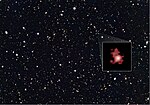astro.wikisort.org - Meteorite
Pr0211 c,[1] sometimes written as Pr 0211 c, is a gas giant exoplanet orbiting around the Sun-like star Pr0211, a G-type main sequence star. Pr0211 c and two other planets, Pr0211 b and Pr0201 b are notable for being one of the first exoplanets discovered in the Beehive cluster located in the constellation Cancer, and for being the first multi-planet system discovered in an open cluster.[1] Its host star, Pr0211, is rotationally variable and has a rotation period of 7.97 days.[2]
This article needs additional citations for verification. (December 2016) |
| Discovery | |
|---|---|
| Discovered by | Sam Quinn |
| Discovery site | University of Georgia |
| Discovery date | 18 February 2016 |
Detection method | Radial Velocity |
| Orbital characteristics | |
Semi-major axis | 5.8 ( -1.4 +2.9 ) AU |
| Eccentricity | 0.7 (± 0.1)[1] |
Orbital period (sidereal) | 5300.0 ( -1800.0 +4450.0 ) (Julian Days)[1] d |
| Star | Pr0211 |
| Physical characteristics | |
| Mass | 7.95 (± 0.25)[1] MJ |
Discovery
Pr0211 c was discovered in 2016 by Luca Malavolta[1][3] and his colleagues while observing its host star with the HARPS-N spectrograph on the 3.6 metres (12 ft; 3.9 yd) Italian Telescopio Nazionale Galileo (TNG) in La Palma, and the Tillinghast Reflector Echelle Spectrograph (TRES) mounted at the 1.5 metres (4.9 ft; 1.6 yd) telescope at the University of Georgia in the United States.
References
- "Planet Pr 0211 c". Exoplanet.eu. Retrieved 2016-04-18.
- Kovács, Géza; Hartman, Joel D.; Bakos, Gáspár Á.; Quinn, Samuel N.; Penev, Kaloyan; Latham, David W.; Bhatti, Waqas; Csubry, Zoltán; De Val-Borro, Miguel (2014). "Stellar rotational periods in the planet hosting open cluster Praesepe". Monthly Notices of the Royal Astronomical Society. 442 (3): 2081. arXiv:1405.3728. Bibcode:2014MNRAS.442.2081K. doi:10.1093/mnras/stu946.
- The GAPS programme with HARPS-N at TNG XI. Pr 0211 in M 44: the first multi-planet system in an open cluster
На других языках
- [en] Pr0211 c
[ru] Pr0211 c
Pr0211 c (иногда также Pr 0211 с) — экзопланета у звезды Pr0211 в созвездии Рака на расстоянии 550 световых лет от Солнца. Относится к газовый гигантам и является второй по удалённости планетой в системе после Pr0211 b. Родительская звезда, очень похожая на Солнце, имеет спектральный класс G9 и также относится к жёлтым карликам. Это одна из первых экзопланетных систем, обнаруженных в звёздном скоплении Ясли и единственная известная система в рассеяном скоплении, в которой больше одной планеты[2].Другой контент может иметь иную лицензию. Перед использованием материалов сайта WikiSort.org внимательно изучите правила лицензирования конкретных элементов наполнения сайта.
WikiSort.org - проект по пересортировке и дополнению контента Википедии


